morio nishimura, "gelber Sand (yellow sand)"june 19 - july 31, 2004taguchi fine art, ltd. |
|
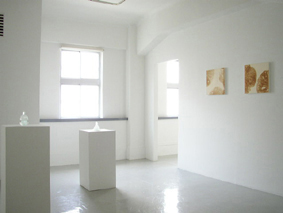
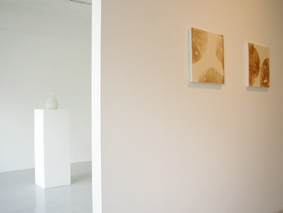
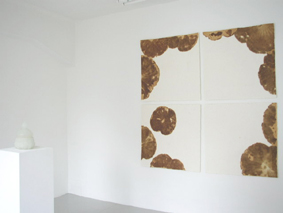
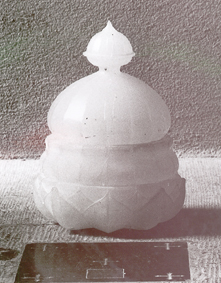
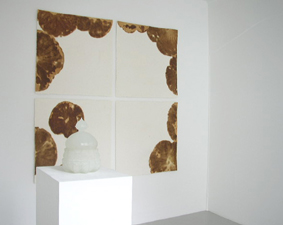
|
Born in Tokyo in 1960, Morio Nishimura now resides in Meerbusch, Germany. After having graduated from Tama Art University in 1985, he moved to Germay as DAAD student in 1991. Got the Meisterschueler from Guenter Ucker at the Art Academy in Duesseldorf in 1995. Under the Japanese government overseas study program for artists, he studied on religion and contemporary art at the department of culture and spiritual history at the art academy in Johannes Gutenberg-University, Mainz from 1998 to 1999 and stayed there as a lecturer for two and half years. In 2001, received the title of "the artist of Kunst-Station Sankt Peter, Koeln 2001-02" . sweet rainNishimura investigates into the relation between human being and the world through taking various religious activities around the world as the motif of his works.On the occasion of his last installation at tagauchi fine art, ltd. in 2002, titled "suesser Regen (sweet rain)" , he exhibited wooden sculptures of which motif is lotus leaves. The motif, "lotus" is very important plant for Buddhism as the symbol of "Rin-ne (emancipation from worldly attachments)" or "Gedatsu (transmigration of the soul)". And it is also the sitting place of Buddha. The title, "sweet rain" is the rain which Ryu-oh (king of dragon) let fall down to the earth to celebrate the birth of Buddha, giving baby Buddha first bath. Living in Germany, always confronting with his own identity as a foreigner from the far east, Nishimura clearly reaffirmed own interest in Buddhism which is already a part of him. Therefore it is quite understandable that works which deals the idea and objects related to Buddhism are getting more and more important in his recent activities. container/ potThis time Nishimura produced glass sculptures with a technique called "pate de verre (glass paste)", which has its origin in ancient Mesopotamia. The technique is, making a mold from original form made of clay, wax or wood and fill it with glass powder and then melt the glass in an oven. With this, Nishimura made glass sculptures, of which motif is a container of Buddha's ashes and cinerary urn.Nishimura says that container gives him an image of connection of inside with outside or this world with the other world. Before being put the lid, the inside of container stays as a clear space, exposed to light. However, the moment covered with the lid, the space inside is suddenly cut off from this world, unknown another world being created. Thus container can be regarded as a symbol of something which easily connects and separates two different worlds. And inside of cinerary urn is actually the other world in which we physically live after our death, leaving from this world. gelber Sand (yellow sand)At first the teaching of Buddha spread orally by his disciples and it was in Khotan Kingdom around BC 400 that the teaching was compiled as Kegon scriptures, becoming the basis of Mahayana Buddhism. Khotan Kingdom was a oasis located close to Hotan city in Taklamakan Desert, now lost in desert.The compilation of scriptures gave Buddhism great power to spread to the world. We Japanese have unfavorable impression of yellow sand from the continental desert, associating with the sand flying over from the basin of the Hwang Ho (the Yellow River) in China which causes atmospheric pollution and gives damage to the crops. However, as a matter of fact, the yellow sand, different from the white sand in seashore, has good ability to preserve water and is easy for us to cultivate. It makes suitable soil for growing potatoes or grain. In Europe, yellow sand is coming from the African Continent. It is said that its expanse gathers people as the good place for cultivation and as the result, ideas and culture spread according to the expansion of the land covered with yellow sand. connection among various imagesYellow sand which has important role to diffuse culture - Khotan Kingdom lost in desert where Kegon scriptures was compiled - Kegon scriptures which gave Buddhism power to spread, stupas bulit to house the container of Buddha's ashes, the visual symbol of the expansion of Buddhism - a container used at Holy Communion in Catholic Churchs - container which connects this world with other world. These complicated association motivates Nishimura to produce the works which installed this time.This is his second show at taguchi fine art, ltd., the first one titled "suesser Regen (sweet rain)" in 2002. Glass sculptures and two dimensional work made of lotus leaves and Japanese paper will be exhibited. Please come to look at beautiful glass sculptures, made with "pate de verre" technique, those surface roughly finished, those shape naturally warped, shining like opal. Maybe good occasion to contemplate about other world ! Nishimura's activity is gradually noticed in Japan, scheduled to join the special group exhibition at Kanagawa prefectural hall gallery in October. checklist of the installation 1. gelber Sand 4-L, 2004 glass, 14 x 8.6 x 8.6 cm 2. gelber Sand 4-L massive, 2004 glass, 14 x 8.6 x 8.6 cm 3. gelber Sand 5-L, 2004 glass, 13 x 13 x 13 cm 4. gelber Sand 5-L massive, 2004 glass, 13 x 13 x 13 cm 5. untitled, 2001 lotus leaves, paper, wood panel, 40 x 40 cm 6. untitled, 2001 lotus leaves, paper, wood panel, 40 x 40 cm 7. gelber Sand 1-L, 2002 glass, 28 x 21 x 21 cm 8. untitled, 2004 lotus leaves paper, 4 pieces, 90 x 90 cm each |